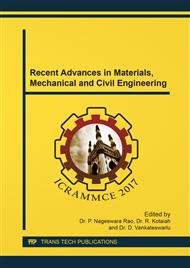[1]
R. Gong, Y. Ding, M. Li, C. Yang, H. Liu, y. Su, Utilization of powdered peanut hull as biosorbent for removal of anionic dyes from aqueous solution, Dyes. Pigm. 64 (2005) 187-192.
DOI: 10.1016/j.dyepig.2004.05.005
Google Scholar
[2]
B. Royer, N.F. Cardoso, E.C. Lima, J.C.P. Vaghetti, N.M. Simon, T. Calvete, R.C. Veses, Applications of Brazilian pine-fruit shell in natural and carbonized forms as adsorbents to removal of methylene blue from aqueous solutions - Kinetic and equilibrium study, J. Hazard. Mater. 164 (2009).
DOI: 10.1016/j.jhazmat.2008.09.028
Google Scholar
[3]
T. Robinson, B. Chandran, P. Nigam, Removal of dyes from an artificial textile dye effluent by two agricultural waste residues, corncob and barley husk, Environ. Int. 28 (2002) 29-33.
DOI: 10.1016/s0160-4120(01)00131-3
Google Scholar
[4]
M. Rafatullah, O. Sulaiman, R. Hashim, A. Ahmad, Adsorption of methylene blue on low-cost adsorbents: A review, J. Hazard. Mater. 177 (2010) 70-80.
DOI: 10.1016/j.jhazmat.2009.12.047
Google Scholar
[5]
E. Rubin, P. Rodriguez, R. Herrero, J. Cremades, I. Barbara, M.E. Sastre de Vicente, Removal of Methylene Blue from aqueous solutions using as biosorbent Sargassum muticum: an invasive macroalga in Europe, J. Chem. Technol. Biotechnol. 80: 291–298 (2005).
DOI: 10.1002/jctb.1192
Google Scholar
[6]
S. Renganathan, J. Kalpana, M.D. Kumar, M. Velan, Equilibrium and Kinetic Studies on the Removal of Reactive Red 2 Dye from an Aqueous Solution Using a Positively Charged Functional Group of the Nymphaea rubra Biosorbent, Clean. 37 (2009) 901-907.
DOI: 10.1002/clen.200900133
Google Scholar
[7]
Y. Bulut, H. Aydın, A kinetics and thermodynamics study of methylene blue adsorption on wheat shells, Desalination 194 (2006) 259-267.
DOI: 10.1016/j.desal.2005.10.032
Google Scholar
[8]
B.H. Hameed, Spent tea leaves: A new non-conventional and low-cost adsorbent for removal of basic dye from aqueous solutions, J. Hazard. Mater. 161 (2009) 753-759.
DOI: 10.1016/j.jhazmat.2008.04.019
Google Scholar
[9]
K.Y. Foo, B.H. Hameed, Coconut husk derived activated carbon via microwave induced activation: Effects of activation agents, preparation parameters and adsorption performance, Chem. Eng. J. 184 (2012) 57-65.
DOI: 10.1016/j.cej.2011.12.084
Google Scholar
[10]
D. Kavitha, C. Namasivayam, Experimental and kinetic studies on methylene blue adsorption by coir pith carbon, Bioresour. Technol. 98 (2007) 14-21.
DOI: 10.1016/j.biortech.2005.12.008
Google Scholar
[11]
B.H. Hameed, R.R. Krishni, S.A. Sata, A novel agricultural waste adsorbent for the removal of cationic dye from aqueous solutions, J. Hazard. Mater. 162 (2009) 305-311.
DOI: 10.1016/j.jhazmat.2008.05.036
Google Scholar
[12]
N. Naveen, P. Saravanan, G. Baskar, S. Renganathan, Equilibrium and kinetic modeling on the removal of Reactive Red 120 using positively charged Hydrilla verticillata, J. Taiwan Inst. Chem. Eng. 42 (2011) 463-469.
DOI: 10.1016/j.jtice.2010.08.007
Google Scholar
[13]
M. Auta, B.H. Hameed, Optimized waste tea activated carbon for adsorption of Methylene Blue and Acid Blue 29 dyes using response surface methodology, The Chem. Eng. J. 175 (2011) 233-243.
DOI: 10.1016/j.cej.2011.09.100
Google Scholar


